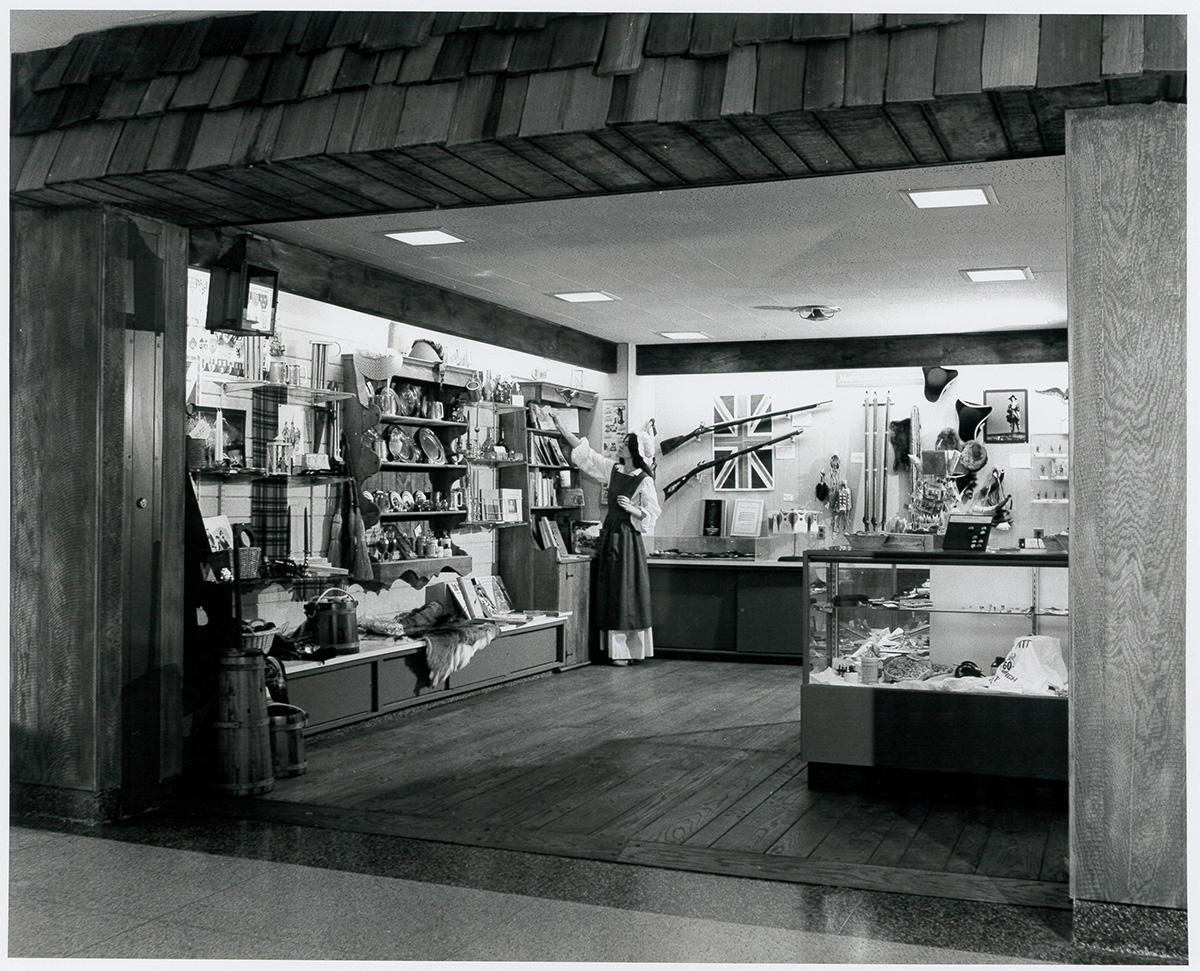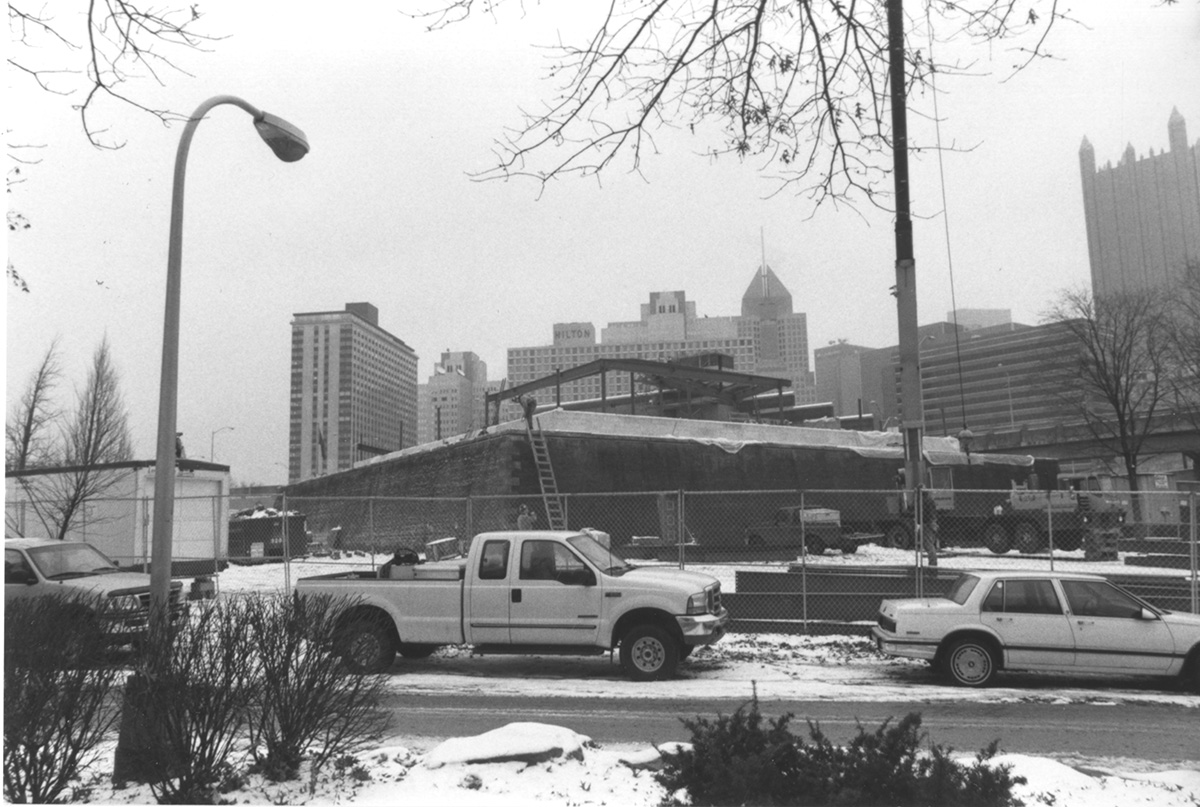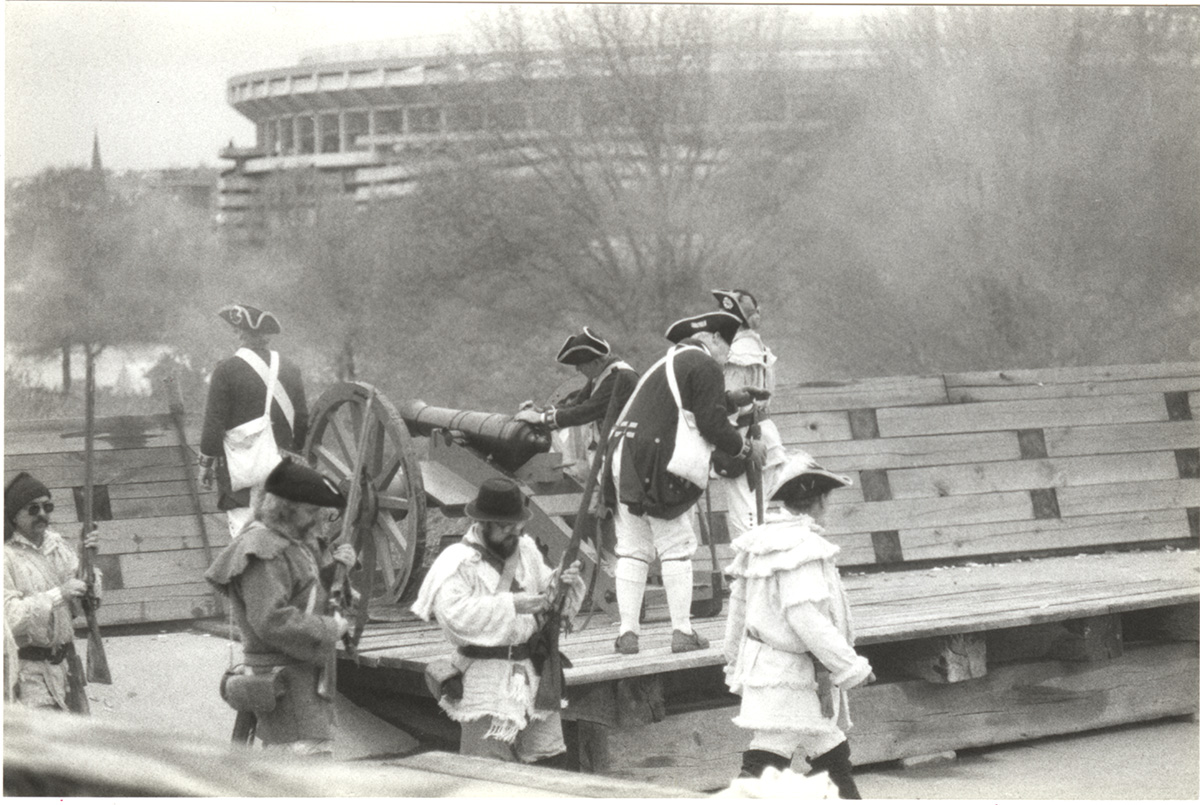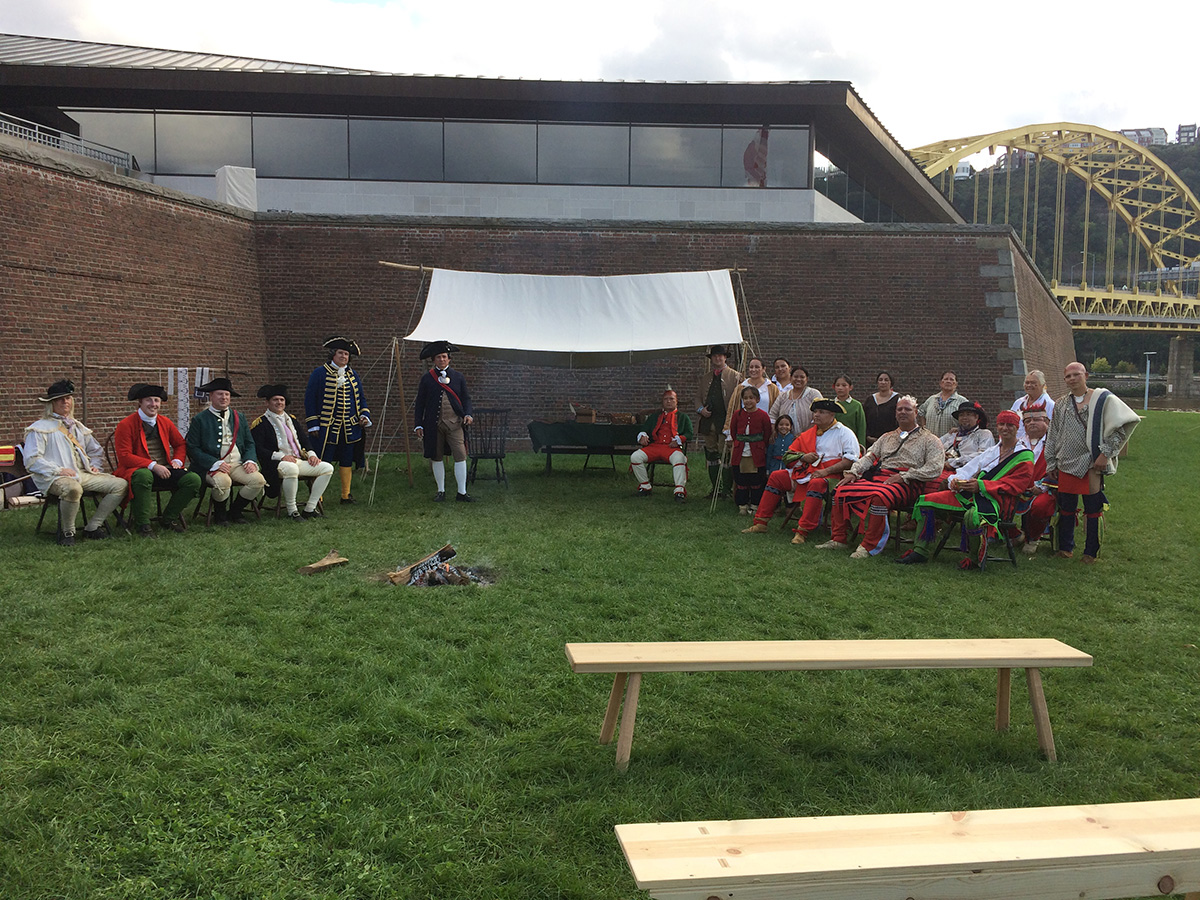This is the second in a two-part series adapted from an article found in Western Pennsylvania History magazine. You can read part one here. Read the full article in the Summer 2019 issue.
In 1971, the state-chartered, volunteer Fort Pitt Museum Associates was formed to operate the Fort Pitt Museum’s gift store, organize public lecture programs, sponsor the changing exhibits, and host the annual Forbes Medal Award, which honored contributors to the promotion of Western Pennsylvania history and art.
 The reenacting unit of the Royal American Regiment, formed in 1972, included volunteer fifers, drummers, and infantrymen. Based on the historic regiment that served at Fort Pitt in the 1760s, the RAR provided public performances on the museum’s sod roof, throughout Point State Park, and at offsite events. Members of the regiment were required to pay $2 per year in dues and participate in regular Monday evening practices for Summer Sunday afternoon performances.[1] One performance, in 1973, presented the Regimental and King’s Colors with Brigadier General H.G. Woods, Commander of the British Army staff from the British Embassy in Washington, D.C.[2]
The reenacting unit of the Royal American Regiment, formed in 1972, included volunteer fifers, drummers, and infantrymen. Based on the historic regiment that served at Fort Pitt in the 1760s, the RAR provided public performances on the museum’s sod roof, throughout Point State Park, and at offsite events. Members of the regiment were required to pay $2 per year in dues and participate in regular Monday evening practices for Summer Sunday afternoon performances.[1] One performance, in 1973, presented the Regimental and King’s Colors with Brigadier General H.G. Woods, Commander of the British Army staff from the British Embassy in Washington, D.C.[2]
Point State Park and its fountain were completed and dedicated on August 30, 1974. Master of Ceremonies Theodore L. Hazlett Jr., Chairman for the Allegheny Conference on Community Development, remarked, “We cannot forget the historical importance of this hallowed ground. The Point symbolizes a milepost in early American history.… Men for decades had dreamed of this site as a monument to our historical past.… The last element of the park—the fountain—is completed today.… It is a fitting symbol for this great and beautiful city in which we all take pride.”[3]
With Point State Park complete, Pittsburgh became known for transforming itself and creating a space to serve its citizens that amplified its natural beauty, recognized its place in national history, solved traffic problems, and utilized building solutions that would aid the city’s future growth.
In addition to its permanent gallery, the Fort Pitt Museum created temporary exhibits that served the museum’s mission of frontier history and expanded the cultural and historical exposure to its visitors. Some past exhibitions included a display of 18th- and 19th-century tools, riverboat models, and a recreated general store that allowed visitors to envision how the frontier had been changed by time and innovation.
In the 18th century, the strategic location of Fort Pitt on the Forks of the Ohio River provided transportation and trade through major river systems throughout colonial North America. When selecting the site for the fort, Colonel Hugh Mercer advised Colonel Henry Bouquet against building on the site of Fort Duquesne due to flooding. However, Bouquet felt that securing the Point was more important than the possibility of flooding.[4]

Today, the Allegheny, Monongahela, and Ohio Rivers are monitored by the U.S. Army Corps of Engineers and 23 locks and dams, but the Fort Pitt Museum was forced to close on several occasions due to flood damage from hurricanes, heavy rains, and snowmelt. During those occasions, collections were moved offsite to neighboring facilities. In 2000, the state received funding to construct a second floor that created 12,000 additional square feet of exhibit space and collections storage. Construction also included the installation of a crane above the Fort Pitt model to lift it to the ceiling out of harm’s way.
Beaver County architect Roger Weaver used the strengths of the building’s location, Stotz’s original design and concept, and historic references to create a soldier’s viewpoint from the second floor: “When visitors walk past a ribbon of windows they will see what a soldier saw when he looked out over Fort Pitt … [the scene] is elegant and very rural. You see trees, grass, and river. It’s kind of a counterpoint to the hustle and bustle that’s behind you in the city.”[5] When the interior of the second floor was completed, it was opened for a one-day art show on June 16, 2001, featuring 20 paintings by Robert Connell, John Buxton, and Robert Griffing.
In 2004, the Fort Pitt Museum opened its completed second-floor permanent exhibit, Fort Pitt: Keystone of the Frontier, including 11 never-before-seen handwritten pages by George Washington from the winter of 1787-88 in which he reflected upon his experiences in the French and Indian War. The event officially marked the launch of the 250th anniversary and national commemoration of the French and Indian War. Fort Pitt Museum worked with both regional and state institutions, including the Historical Society of Western Pennsylvania (HSWP), to promote the anniversary with exhibits and programming.

In August 2009, PHMC closed the Fort Pitt Museum to help reduce the state’s budget deficit. Three organizations offered to continue operations: Friends of the Fort Pitt Museum (which was Fort Pitt Museum Associates), Soldiers & Sailors Memorial Hall and Museum, and HSWP.[6] It was decided that HSWP would assume operations of the museum under contract with the PHMC, thereby utilizing the expertise and resources available at the society.[7]
Fort Pitt Museum re-opened on April 17, 2010, with a Colonial Fair[8] offered jointly with HSWP—the two-day event, with free shuttle rides between the two locations, allowed visitors to explore the updated exhibits and enjoy artisans, musicians, demonstrations, and performances by American Indians, first-person costumed interpreters, and hands-on crafts. Visitors also enjoyed new additions to the museum such as a new life figure representative of an 18th-century Seneca Indian in the fur trader’s cabin. Of significance is a metal writing stand that belonged to Christopher Davenport, nephew of Benjamin Franklin, who ran a trading post at Fort Pitt in the 1760s; it was the first time the desk had been back at the Forks of the Ohio in over 200 years.[9]
Since HSWP assumed operations, the Fort Pitt Museum has increased its presence in Point State Park and downtown Pittsburgh, revitalized its living history programming, and opened changing exhibits reflecting the history and artistic influence of the Forks of the Ohio River. Recent exhibits explored the American rifleman, the film “Unconquered” and the 1763 siege on Fort Pitt, American Indian captivity, artwork inspired by history, and powder horns.
While HSWP did not resurrect the Royal American Regiment, it reorganized the Fort Pitt Museum’s living history and educational programming based on new research into historically accurate clothing and accruements. Fort Pitt Museum volunteer costumed reenactors participate in musket and cannon demonstrations and 18th-century life demonstrations that include blacksmithing, carpentry, and laundry, the last of which allow visitors to learn more about women on the frontier. Volunteers also participate in multiple youth programs that expose students and families to the history of the Point and explain why, 260 years later, it’s still important to continue learning about the history of the area.

One thing that was missing from the Fort Pitt Museum’s story was a stronger indigenous viewpoint. A joint effort between the museum and HSWP’s other site, Meadowcroft Rockshelter and Historic Village, promoted American Indian programming and exhibits provided and consulted on by descendants of the historic 18th-century tribes of the Forks of the Ohio and Ohio Country. In September 2018, Fort Pitt Museum hosted members of the Delaware Tribe of Indians in the 240th commemoration of the Treaty of Fort Pitt, the United States’ first treaty with an American Indian nation, signed in 1778. The two-day program included a school program for 300 fifth graders from Pittsburgh Public Schools and a public program for visitors to Point State Park and the Fort Pitt Museum. Programming included hands-on American Indian-related activities and crafts, cooking and dance demonstrations, a lecture by Dr. David Preston, author of “Braddock’s Defeat: The Battle of the Monongahela and the Road to Revolution,” and a reenactment of treaty negotiations between American and Delaware leaders. In addition to explaining the historical significance of the treaty and frontier relations, the program also allowed visitors to interact with and learn about the vibrant living culture of American Indians.
Who know what the next 50 years of the Fort Pitt Museum will hold, but in viewing its past, there are many more stories for the Fort Pitt Museum to tell.
[1] “Information Package for Royal American Regiment, January 21, 1972, from Rex T. Lohmann, Curator, Fort Pitt Museum,” Record Group 13, Records of the Pennsylvania Historical and Museum Commission, Bureau of Museums, Administration File (13-0757), Courtesy of Pennsylvania Historical and Museum Commission Pennsylvania State Archives.
[2] Ross, Maddy. “Armed with New Muskets, Colonials to Rally at Point,” The Pittsburgh Press, June 10, 1973, pg. A-2.
[3] Alberts. “Shaping of the Point,” pg. 3.
[4] Leonard, Autumn L, Donald H. Kent, and Louis M. Waddell, eds. “Colonel Henry Bouquet to Colonel Hugh Mercer, 8 May 1759,” The Papers of Henry Bouquet, Volume III January 1, 1759–August 31, 1759, Harrisburg: Pennsylvania Historical and Museum Commission, 1976, pg. 273.
[5] Pitz, Marylynne. “Fort Pitt Museum job tests architect,” Pittsburgh Post-Gazette, January 17, 2001, pg. D-3.
[6] Fuoco, Linda Wilson. “Group releases plan to run Fort Pitt Museum,” Pittsburgh Post-Gazette, June 1, 2009, pg. B-1.
[7] Boyer, Lauren. “Heinz History Center to operate Fort Pitt Museum,” Pittsburgh Post-Gazette, June 18, 2009, pg. B-1.
[8] Barcousky, Len. “New Faces at Fort Pitt Museum,” Pittsburgh Post-Gazette, April 15, 2010, B-1.
[9] Barcousky, Len. “Fort Pitt Museum ready for reopening,” Pittsburgh Post-Gazette, April 11, 2010, pg. F-1.
Kathleen Lugarich is the education manager at the Fort Pitt Museum.